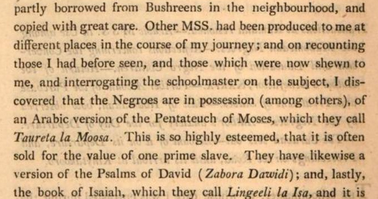1795 AD – 1797 AD: Negroes In Possession of Pentateuch Written In Arabic
Source: Google Books Author: James Rennell Mungo Park Publication Date: 1799 AD Dates Referenced: 1795 AD, 1796 AD, and 1797 AD Title: Travels in the Interior Districts of Africa: Performed Under the Direction and Patronage of the African Association, in the Years 1795, 1796, and 1797 Pages: 314 – 316 More Info “Exclusive of the…
Read More “1795 AD – 1797 AD: Negroes In Possession of Pentateuch Written In Arabic” »



You must be logged in to post a comment.